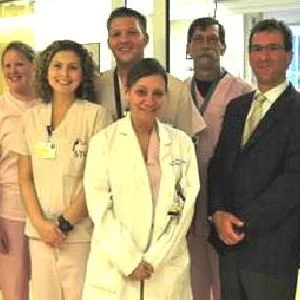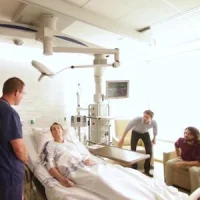A critical care resuscitation unit (CCRU) at the University of Maryland Medical Center (UMMC) has significantly improved transfer times for non-trauma critically ill patients, according to a study in press in the Journal of the American College of Surgeons. Speaking to ICU Management & Practice, co-author Lewis Rubinson, MD, PhD, Associate Professor of Medicine at University of Maryland School of Medicine, said, “We believe this is a game changer. We have begun to emulate the trauma system for non-trauma time-sensitive critical care and believe this is a logical and powerful way for academic centres to coordinate all of their time-sensitive transfers rather than having them occur haphazardly.”
In the U.S. systems exist for trauma patients to be transferred to specialised centres, but to date no such systems have been in place to transfer non-trauma patients who need critical care. Dr. Rubinson explained the reasons for establishing the new unit: “Historically we did what most academic centres do, we had a robust consultation and transportation centre which would bring patients directly to ICU beds. We even used ICU beds from less relevant specialties to make more space for emergent patients, but we had significant delays and difficulty getting critically ill patients to UMMC. This was most concerning for those with time-sensitive illness such as those requiring emergent evaluation and operative intervention.”
He added: “Direct transfer to ICUs makes sense to reduce another round of handoffs. The dilemma is that availability for admissions must be 24/7. Workflow in ICUs works contrary to admissions when there are many patients to round on—either rounding gets short changed or the admission does not receive all hands on deck. When rounds are over, direct transfers could receive more attention but there is not always bed availability. In addition, most ICUs are not set up to take the referring facilities' information and establish a pre-arrival readiness posture to be able to optimise immediate evaluation, resuscitation and intervention for patients. Lastly, if we directly admitted to each specialty ICU than each would require 24/7 open staffed available beds to be able to meet emergent demand. We have 7 adult specialty ICUs and the amount of resources which would be required to make sure each individually is always ready for an emergent admission would be tremendous. Also, the different ICUs would not have optimal capability to take a patient outside of their specialty. The ability to move patients from receipt and resuscitation allows for an ongoing readiness posture to take the next patient.”
See Also: Emergency Medicine in Switzerland
The CCRU was set up in July 2013 to provide rapid evaluation of critically ill non-trauma patients, even before transfer. It is a 6-bed, short-stay ICU, staffed 24/7 by an attending intensivist who triages and manages CCRU patients. The goals are to:
Patient rooms are prepared in advance, and after initial resuscitation and possible surgical care, patients are moved to the appropriate sub-specialty ICU for ongoing care. The unit is funded by a partnership with the medical centre that defers some costs. The additional medical centre revenue from the increased volume allowed both the medical center and the CCRU practice plan to be profitable.
In its first full year of operation, for the subset of adult patients admitted for critical care, transfers increased 64.5 percent compared to a previous year (2,228 vs. 1,354), with a 93.6% increase in critically ill surgical patients. Of the 2,228 patients, 1,318 (59.2%) were transferred to the CCRU; the remaining 910 patients were transferred directly to a UMMC ICU.Significantly more transfer patients required an operation during their hospital stay (46 percent vs. 31.1 percent) and a higher percentage were in the operating room within 12 hours of arriving (41 percent vs. 21.4 percent). For patients requiring operations, median time to arrival and operating room (118 vs 223 minutes and 1,113 vs 3,424 minutes, respectively) and median hospital length of stay (13 vs 17 days) were reduced significantly. The mean time patients spend in the CCRU is approximately 8 hours. Patients arrived in nearly half the time (129 vs. 234 minutes). The CCRU also significantly decreased the percentage of lost admissions from 25.7 percent to 14 percent in this subset.
Despite improved time to ICU admission, there was a non-significant reduction in mortality. The authors explain, “Although the entire CCRU cohort, and the subset requiring surgery, trended toward lower mortality, convincing evidence for improved outcomes was not found. The comparison groups might have had different conditions and severity of illness, but currently available data did not allow for physiologic risk adjustment. Among the CCRU patients, a higher percentage required an operation during their hospital stay and an urgent operation within 12 hours of arrival, suggesting higher acuity. It seems reasonable to conclude that these were the patients who previously were lost admissions.”
The authors are hopeful that continued research will produce definitive data showing that the CCRU lowers mortality for patients.
Claire Pillar
Managing Editor, ICU Management & Practice
Image shows some of the CCRU team
Source and image credit: University of Maryland Medical Center
In the U.S. systems exist for trauma patients to be transferred to specialised centres, but to date no such systems have been in place to transfer non-trauma patients who need critical care. Dr. Rubinson explained the reasons for establishing the new unit: “Historically we did what most academic centres do, we had a robust consultation and transportation centre which would bring patients directly to ICU beds. We even used ICU beds from less relevant specialties to make more space for emergent patients, but we had significant delays and difficulty getting critically ill patients to UMMC. This was most concerning for those with time-sensitive illness such as those requiring emergent evaluation and operative intervention.”
He added: “Direct transfer to ICUs makes sense to reduce another round of handoffs. The dilemma is that availability for admissions must be 24/7. Workflow in ICUs works contrary to admissions when there are many patients to round on—either rounding gets short changed or the admission does not receive all hands on deck. When rounds are over, direct transfers could receive more attention but there is not always bed availability. In addition, most ICUs are not set up to take the referring facilities' information and establish a pre-arrival readiness posture to be able to optimise immediate evaluation, resuscitation and intervention for patients. Lastly, if we directly admitted to each specialty ICU than each would require 24/7 open staffed available beds to be able to meet emergent demand. We have 7 adult specialty ICUs and the amount of resources which would be required to make sure each individually is always ready for an emergent admission would be tremendous. Also, the different ICUs would not have optimal capability to take a patient outside of their specialty. The ability to move patients from receipt and resuscitation allows for an ongoing readiness posture to take the next patient.”
See Also: Emergency Medicine in Switzerland
The CCRU was set up in July 2013 to provide rapid evaluation of critically ill non-trauma patients, even before transfer. It is a 6-bed, short-stay ICU, staffed 24/7 by an attending intensivist who triages and manages CCRU patients. The goals are to:
- increase the transfer volume of critically ill patients
- decrease lost admissions
- minimise transfer times, and
- improve outcomes
Patient rooms are prepared in advance, and after initial resuscitation and possible surgical care, patients are moved to the appropriate sub-specialty ICU for ongoing care. The unit is funded by a partnership with the medical centre that defers some costs. The additional medical centre revenue from the increased volume allowed both the medical center and the CCRU practice plan to be profitable.
In its first full year of operation, for the subset of adult patients admitted for critical care, transfers increased 64.5 percent compared to a previous year (2,228 vs. 1,354), with a 93.6% increase in critically ill surgical patients. Of the 2,228 patients, 1,318 (59.2%) were transferred to the CCRU; the remaining 910 patients were transferred directly to a UMMC ICU.Significantly more transfer patients required an operation during their hospital stay (46 percent vs. 31.1 percent) and a higher percentage were in the operating room within 12 hours of arriving (41 percent vs. 21.4 percent). For patients requiring operations, median time to arrival and operating room (118 vs 223 minutes and 1,113 vs 3,424 minutes, respectively) and median hospital length of stay (13 vs 17 days) were reduced significantly. The mean time patients spend in the CCRU is approximately 8 hours. Patients arrived in nearly half the time (129 vs. 234 minutes). The CCRU also significantly decreased the percentage of lost admissions from 25.7 percent to 14 percent in this subset.
Despite improved time to ICU admission, there was a non-significant reduction in mortality. The authors explain, “Although the entire CCRU cohort, and the subset requiring surgery, trended toward lower mortality, convincing evidence for improved outcomes was not found. The comparison groups might have had different conditions and severity of illness, but currently available data did not allow for physiologic risk adjustment. Among the CCRU patients, a higher percentage required an operation during their hospital stay and an urgent operation within 12 hours of arrival, suggesting higher acuity. It seems reasonable to conclude that these were the patients who previously were lost admissions.”
The authors are hopeful that continued research will produce definitive data showing that the CCRU lowers mortality for patients.
Claire Pillar
Managing Editor, ICU Management & Practice
Image shows some of the CCRU team
Source and image credit: University of Maryland Medical Center
References:
Scalea TM, Rubinson L, Tran Q, Jones KM, Rea JH, Stein
DM, Bartlett ST, O'Connor JV (2016) Critical Care Resuscitation Unit: an innovative solution to expedite transfer of patients with time-sensitive critical illness. J Am Coll Surg, pii:
S1072-7515(16)00073-9. doi: 10.1016/j.jamcollsurg.2015.12.060. [Epub
ahead of print]
Latest Articles
critical care, resuscitation, patient transfer
A critical care resuscitation unit (CCRU) at the University of Maryland Medical Center (UMMC) has significantly improved transfer times for non-trauma critically ill patients, according to a study in press in the Journal of the American College of Surgeon










